Preparation of a Polypyrrole-Polyvinylsulphonate Composite Film Biosensor for Determination of Cholesterol Based on Entrapment of Cholesterol Oxidase
Abstract
:1. Introduction
2. Materıal and Methods
2.1. Instrumentation and Reagents
2.2. Preparation of Cholesterol Solution
2.3. Preparation of Pt/PPy–PVS Film Electrode
2.4. Immobilizaton of Cholesterol oxidase on Pt/PPy-PVS Film Electrode
2.5. Amperometric Biosensor Measurements
3. Result and Discussion
3.1. The Working Potential
3.2. Effects of pH and Temperature
3.3. Effect of Substrate Concentration on Biosensor
3.4. Operational Stability and Storage Stability
3.5. Interference Effect
4. Conclusions
Acknowledgments
References
- Liu, J.; Agarwal, M.; Varahramyan, K. Glucose sensor based on organic thin film transistor using glucose oxidase and conducting polymer. Sens. Actuat. B 2008, 135, 195–199. [Google Scholar]
- Vidal, J.C.; Garcia-Ruiz, S.; Méndez, P.; Castillo, J.R. Three approaches to the development of selective bilayer amperometric biosensors for glucose by in situ electropolymerization. Analyst 1999, 124, 319–324. [Google Scholar]
- Vidal, J.C.; Espuelas, J.; Garcia, E.; Castillo, J.R. Amperometric cholesterol biosensors based on the electropolymerization of pyrrole and the electrocatalytic effect of Prussian-Blue layers helped with self-assembled monolayers. Talanta 2004, 64, 655–664. [Google Scholar]
- Hodak, J.; Etchenique, R.; Calvo, E.J.; Singhal, K.; Bartlett, P.N. Layer-by-layer self-assembly of glucose oxidase with a poly(allylamine) ferrocene redox mediator. Langmuir 1997, 13, 2708–2716. [Google Scholar]
- Nicolini, C. Molecular manufacturing. In Electronics and Biotechnology Advanced (Elba) Forum Series; Plenum: New York, NY, USA, 1996; Volume 2, pp. 1–270. [Google Scholar]
- Anicet, N.; Bourdillon, C.; Demaille, C.; Moiroux, J.; Savéant, J.M. Catalysis of the electrochemical oxidation of glucose by glucose oxidase and a single electron cosubstrate: kinetics in viscous solutions. J. Electroanal. Chem 1996, 410, 199–202. [Google Scholar]
- Çete, S.; Yaşar, A.; Arslan, F. An amperometric biosensor for uric acid determination prepared from uricase ımmobilized in polypyrrole film. Artif. Cells Blood Substit. Biotechnol 2006, 34, 367–380. [Google Scholar]
- Çete, S.; Yaşar, A.; Arslan, F. Immobilization of uricase upon polypyrrole-ferrocenium film. Artif. Cells Blood Substit. Biotechnol 2007, 35, 607–620. [Google Scholar]
- Arslan, F. An amperometric biosensor for uric acid determination prepared from uricase immobilized in polyaniline-polypyrrole film. Sensors 2008, 8, 5492–5500. [Google Scholar]
- Shimidzu, T.; Ohtani, A.; Honda, K. Charge-controllable polypyrrole/polyelectrolyte composite membranes. III: Electrochemical deionization system constructed by anion-exchangeable and cation-exchangeable polypyrrole electrodes. J. Electroanal. Chem 1988, 251, 323–337. [Google Scholar]
- Li, G.; Wang, Y.; Xu, H. A hydrogen peroxide sensor prepared by electropolymerization of pyrrole based on screen-printed carbon paste electrodes. Sensors 2007, 7, 239–250. [Google Scholar]
- Chaubey, A.; Gerard, M.; Singhal, M.; Singh, V.S.; Malhotra, B.D. Immobilization of lactate dehydrogenase on electrochemically prepared polypyrrole–polyvinylsulphonate composite films for application to lactate biosensors. Electrochim. Acta 2000, 46, 723–729. [Google Scholar]
- Karube, I.; Hara, K.; Matsuoka, H.; Suzuki, S. Amperometric determination of total cholesterol in serum with use of immobilized cholesterol esterase and cholesterol oxidase. Anal. Chim. Acta 1982, 139, 127–132. [Google Scholar]
- Tsai Siao, Y.C.; Chen, Y.; Lee, C.A. Amperometric cholesterol biosensors based on carbon nanotube–chitosan–platinum–cholesterol oxidase nanobiocomposite. Sens. Actuat. B 2008, 135, 96–101. [Google Scholar]
- Nauck, M.; Marz, M.; Jarausch, J.; Cobbaert, C.; Sagers, A.; Bernard, D.; Delanghe, J.; Honauer, G.; Lehmann, P.; Oestrich, E.; Eckardstein, A.; Walch, S.; Wieland, H.; Assmann, G. Multicenter evaluation of a homogeneous assay for HDL-cholesterol without sample pretreatment. Clin. Chem 1997, 43, 1622–1629. [Google Scholar]
- Brahim, S.; Narinesing, D.; Guiseppi-Elie, A. Amperometric determination of cholesterol in serum using a biosensor of cholesterol oxidase contained within apolypyrrole–hydrogel membrane. Analyt. Chim. Acta 2001, 448, 27–36. [Google Scholar]
- Ram, M.K.; Bertoncello, P.; Ding, H.; Paddeu, S.; Nicolini, C. Cholesterol biosensors prepared by layer-by-layer technique. Biosens. Bioelectron 2001, 16, 849–856. [Google Scholar]
- Moraes, M.L.; de Souza, N.C.; Caio, O.H.; Marystela, F.; Ubirajara, P.; Rodrigues, F.; Antonio, R., Jr.; Valtencir, Z.; Osvaldo, N.O., Jr. Immobilization of cholesterol oxidase in LbL films and detection of cholesterol using ac measurements. Mater. Sci. Eng. C 2009, 29, 442–447. [Google Scholar]
- Yang, M.H.; Yang, Y.; Yang, H.F.; Shen, G.; Yu, R.Q. Layer-by-layer self-assembled multilayer films of carbon nanotubes and platinum nanoparticles with polyelectrolyte for the fabrication of biosensors. Biomaterials 2006, 27, 246–255. [Google Scholar]
- Vidal, J.C.; Garcia-Ruiz, E.; Espuelas, J.; Aramendia, T.; Castillo, J.R. Comparison of biosensors based on entrapment of cholesterol oxidase and cholesterol esterase in electropolymerized films of polypyrrole and diaminonaphthalene derivatives for amperometric determination of cholesterol. Anal. Bioanal. Chem 2003, 377, 273–280. [Google Scholar]
- Bongiovanni, C.; Ferri, T.; Poscia, A.; Varalli, M.; Santucci, R.; Desideri, A. An electrochemical multienzymatic biosensor for determination of cholesterol. Bioelectrochemistry 2001, 54, 17–22. [Google Scholar]
- Yamato, H.; Koshiba, T.; Ohwa, M.; Wernet, W.; Matsumura, M. A new method for dispersing palladium microparticles in conducting polymer films and its application to biosensors. Synth. Met 1997, 87, 231–236. [Google Scholar]
- Arjsiriwat, S.; Tanticharoen, M.; Kirtikara, K.; Aoki, K.; Somasundrum, M. Metal-dispersed conducting polymer-coated electrode used for oxidase-based biosensors. Electrochem. Commun 2000, 2, 441–444. [Google Scholar]
- Hrapovic, S.; Liu, Y.; Male, K.B.; Luong, J.H.T. Electrochemical biosensing platforms using platinum nanoparticles and carbon nanotubes. Anal. Chem 2004, 76, 1083–1088. [Google Scholar]
- Ren, X.; Meng, X.; Tang, F. Preparation of Ag–Au nanoparticle and its application to glucose biosensor. Sens. Actuat. B 2005, 110, 358–363. [Google Scholar]
- Becerik, I.; Kadirgan, F. Electrocatalytic properties of platinum particles incorporated with polypyrrole films in D-glucose oxidation in phosphate media. J. Electroanal. Chem 1989, 436, 189–193. [Google Scholar]
- Huang, H.; Yuan, Q.; Yang, X. Preparation and characterization of metal-chitosan nanocomposites. Colloid Surf. B: Biointerfaces 2004, 39, 31–37. [Google Scholar]
- Vidal, J.C.; Garcia-Ruiz, E.; Castillo, J.R. Strategies for the improvement of an amperometric cholesterol biosensor based on electropolymerization in flow systems: use of charge-transfer mediators and platinization of the electrode. J. Pharm. Biomed. Anal 2000, 24, 51–63. [Google Scholar]
- Domínguez Sánchez, P.; Tunon Blanco, P.; Fernández Alvarez, J.M.; Smyth, M.R.; O’Kennedy, R. Flow-injection analysis of hydrogen peroxide using a horseradish peroxidase-modified electrode detection system. Electroanalysis 1990, 2, 303–308. [Google Scholar]
- Hendji, A.N.; Bataillard, P.; Jaffrezic-Renault, N. Covalent immobilization of glucose oxidase on silanized platinum microelectrode for the monitoring of glucose. Sens. Actuat. B 1993, 15, 127–134. [Google Scholar]
- Hall, S.B.; Khudaish, E.A.; Hart, A.L. Electrochemical oxidation of hydrogen peroxide at platinum electrodes. Part V: inhibition by chloride. Electrochim. Acta 2000, 45, 3573–3579. [Google Scholar]
- Karyakin, A.A. Prussian Blue based nano-electrode arrays for detection of H2O2 with advanced analytical performances. Electroanalysis 2001, 13, 813–819. [Google Scholar]
- Gooding, J.J.; Hibbert, D.B. The application of alkane thiol self-assembled monolayers to enzyme electrodes. TRAC Trends Anal. Chem 1999, 18, 525–533. [Google Scholar]
- Vidal, J.C.; Espuelas, J.; Garcia-Ruiz, E.; Castillo, J.R. Amperometric cholesterol biosensors based on the electropolymerization of pyrrole and the electrocatalytic effect of Prussian-Blue layers helped with self-assembled monolayers. Talanta 2004, 64, 655–664. [Google Scholar]
- Yapar, E.; Kayahan, S.K.; Bozkurt, A.; Toppare, L. Immobilizing cholesterol oxidase in chitosan–alginic acid network. Carbohydr. Polym 2009, 76, 430–436. [Google Scholar]
- Cochet, M.; Maser, W.K.; Benito, A.M.; Callejas, M.A.; Martínez, M.T.; Benoit, J.M.; Schreiber, J.; Chauvet, O. Synthesis of a new polyaniline/nanotube composite: in-situ polymerisation and charge transfer through site-selective interaction. Chem. Commun 2001, 1, 1450–1451. [Google Scholar]
- Zhang, Y.; Wen, G.; Zhou, Y.; Shuang, S.; Dong, C.; Choi, M.M.F. Development and analytical application of an uric acid biosensor using an uricase-immobilized eggshell membrane. Biosens. Bioelectron 2007, 22, 1791–1797. [Google Scholar]
- Tan, X.; Li, M.; Cai, P.; Luo, L.; Zou, X. An amperometric cholesterol biosensor based on multiwalled carbon nanotubes and organically modified sol-gel/chitosan hybrid composite film. Analyt. Biochem 2005, 337, 111–120. [Google Scholar]
- Singh, S.; Chaubey, A.; Malhotra, B.D. Amperometric cholesterol biosensor based on immobilized cholesterol esterase and cholesterol oxidase on conducting polypyrrole films. Analyt. Chim. Acta 2004, 502, 229–234. [Google Scholar]
- Wang, H.; Mu, S. Bioelectrochemical characteristics of cholesterol oxidase immobilized in a polyaniline film. Sens. Actuat. B 1999, 56, 22–30. [Google Scholar]
- Arya, S.K.; Prusty, A.K.; Singh, S.P.; Solanki, P.R.; Pandey, M.K.; Datta, M.; Malhotra, B.D. Cholesterol biosensor based on N-(2-aminoethyl)-3-aminopropyl-trimethoxysilane self-assembled monolayer. Analyt. Biochem 2007, 363, 210–218. [Google Scholar]
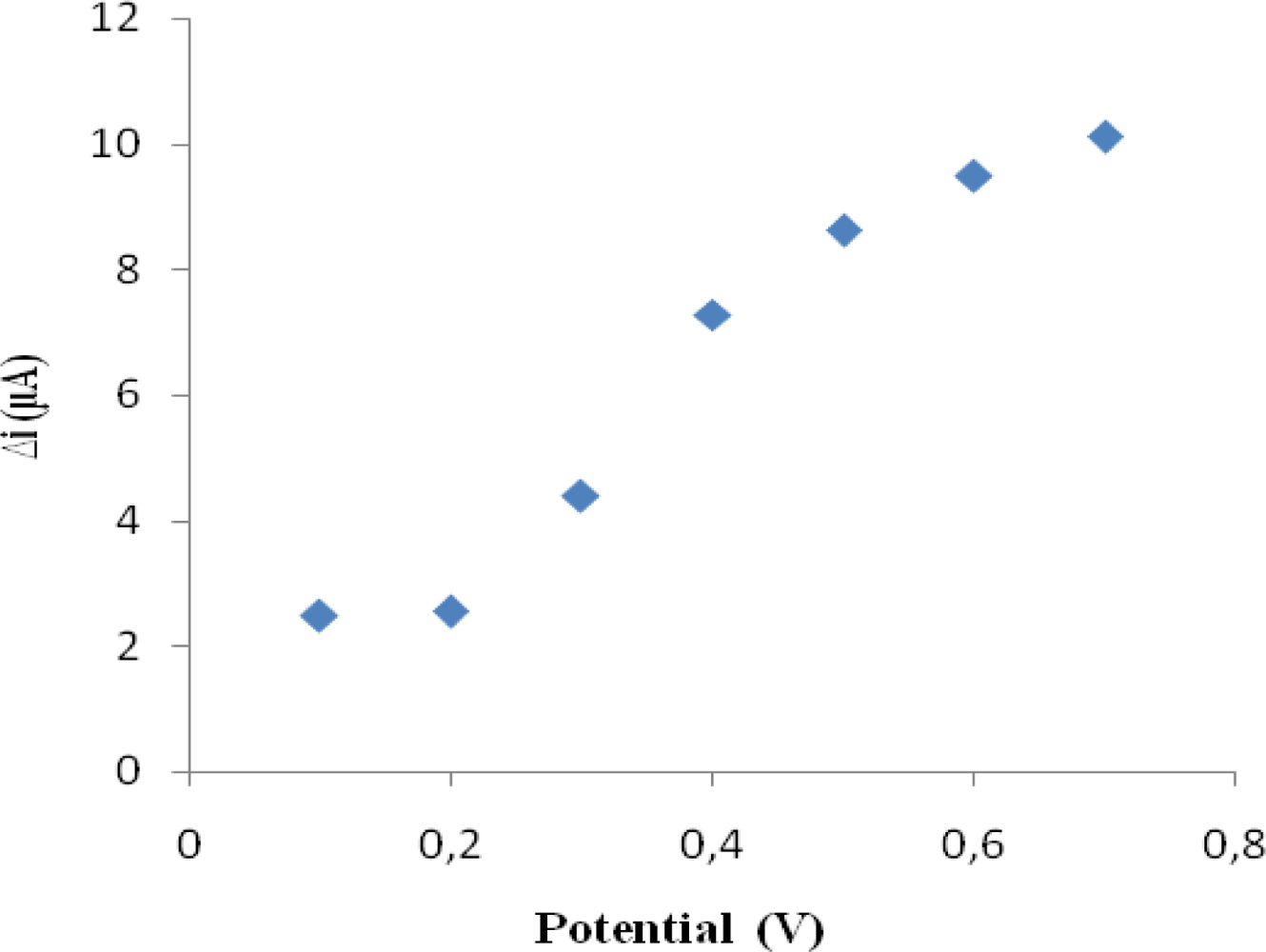
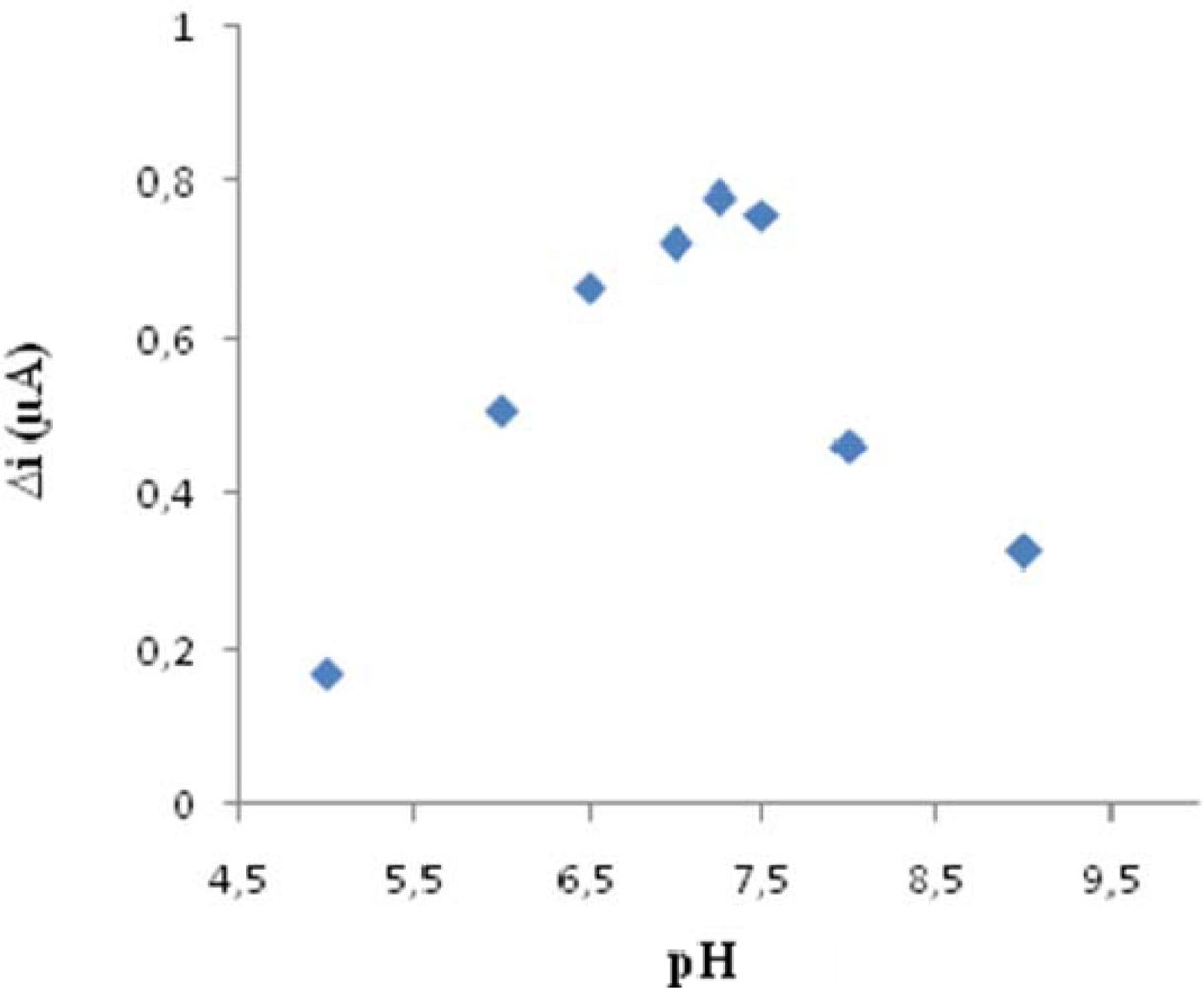
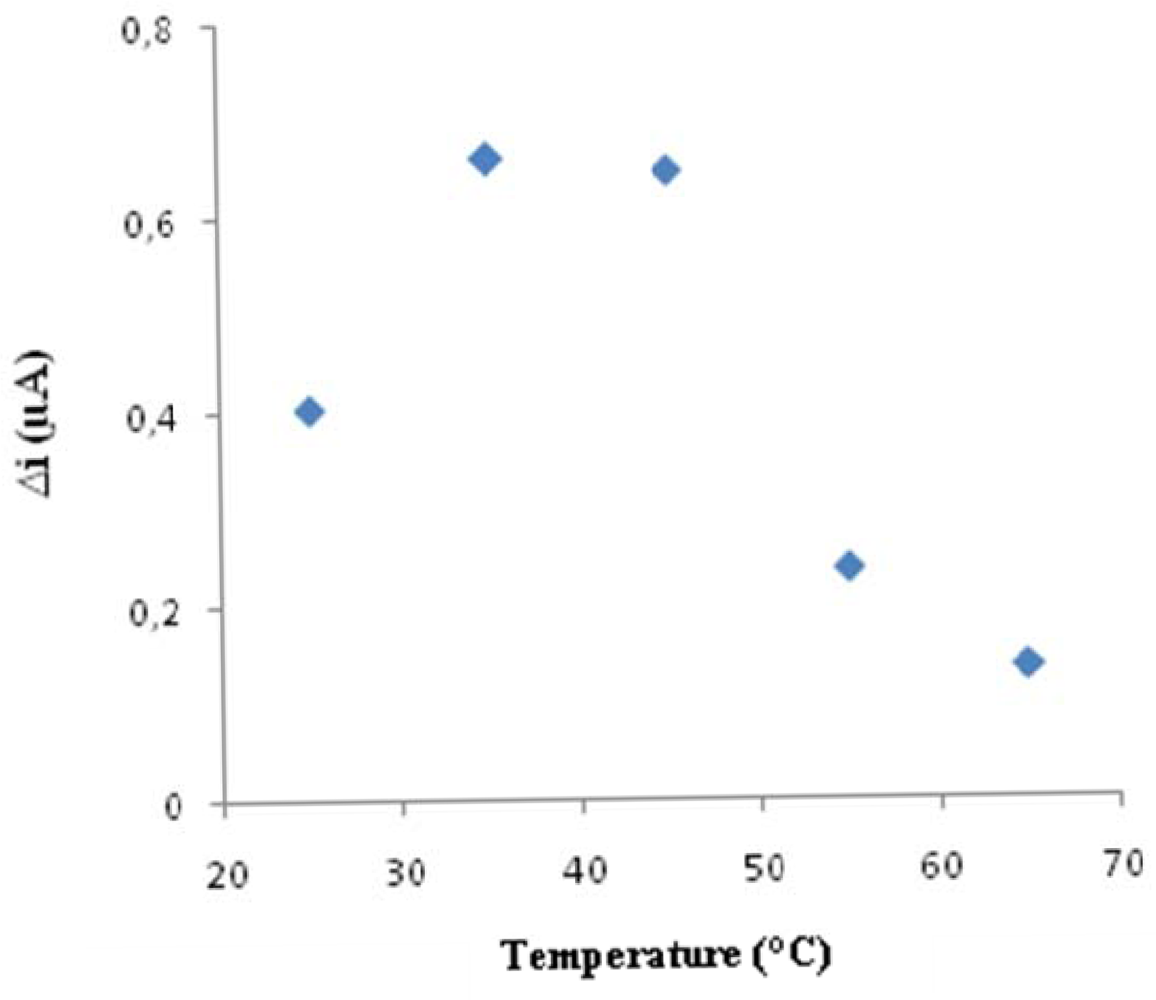
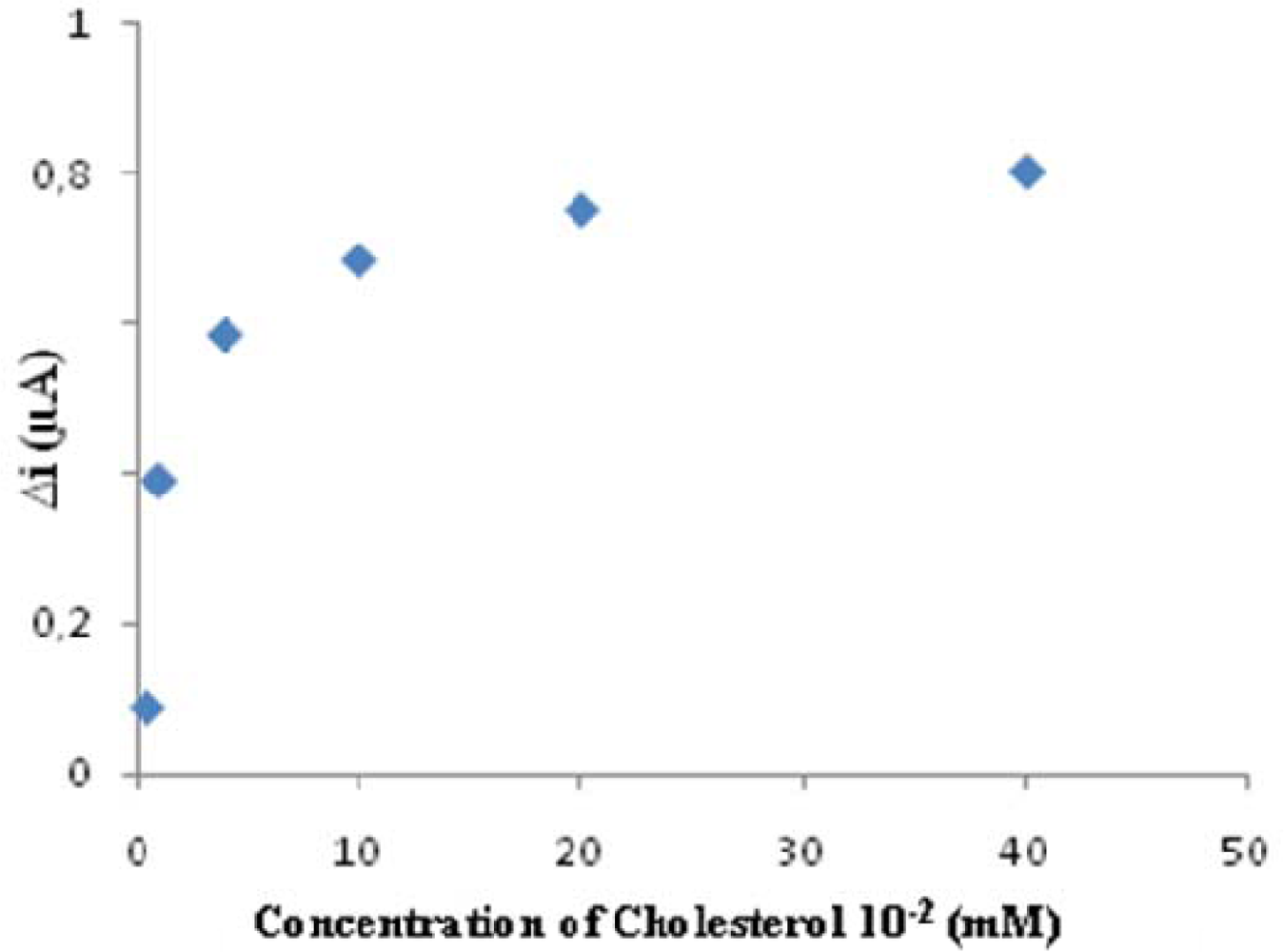
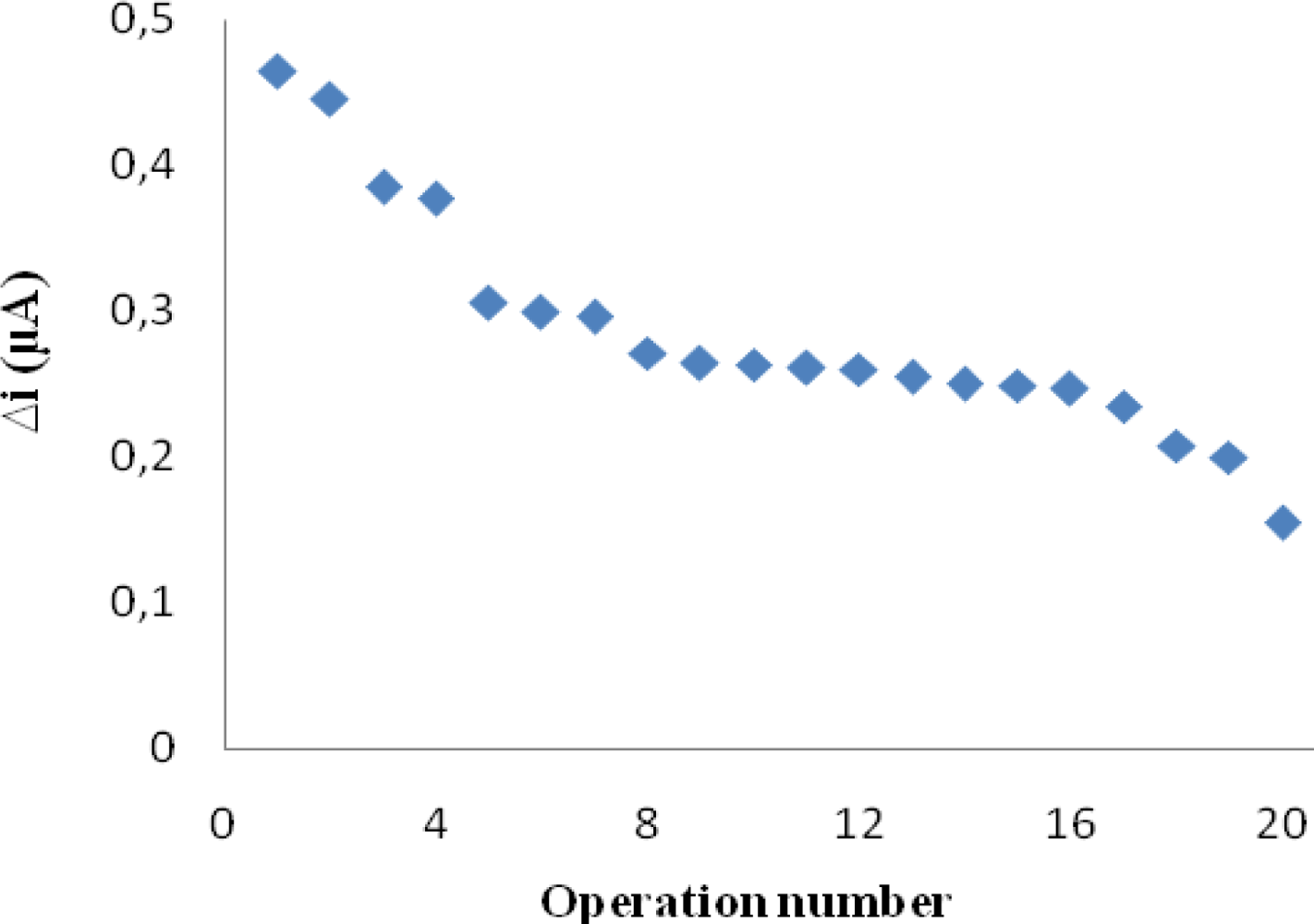
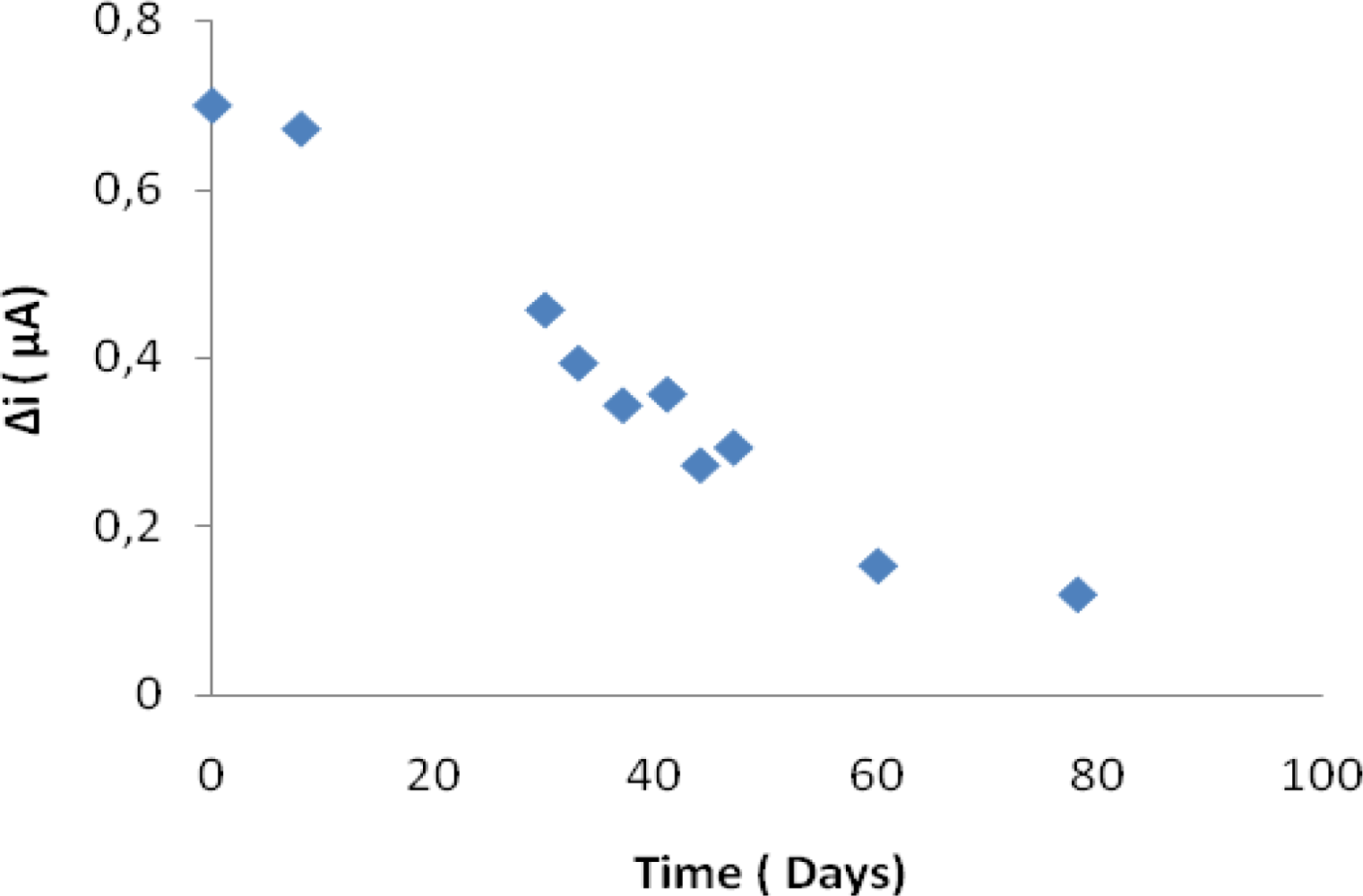
| Interfering substances | Concentration | Response current of interfering substances (μA) |
|---|---|---|
| Glucose | 5 × 10−3(blood) | 0.063 |
| Uric acid | 1 × 10−4(blood) | - |
| Paracetamol (acetaminophen) | 1 × 10−4(blood) | 0.602 |
| Ascorbic acid | 1 × 10−4(blood) | 0.176 |
© 2009 by the authors; licensee MDPI, Basel, Switzerland This article is an open access article distributed under the terms and conditions of the Creative Commons Attribution license (http://creativecommons.org/licenses/by/3.0/).
Share and Cite
Yıldırımoğlu, F.; Arslan, F.; Çete, S.; Yaşar, A. Preparation of a Polypyrrole-Polyvinylsulphonate Composite Film Biosensor for Determination of Cholesterol Based on Entrapment of Cholesterol Oxidase. Sensors 2009, 9, 6435-6445. https://doi.org/10.3390/s90806435
Yıldırımoğlu F, Arslan F, Çete S, Yaşar A. Preparation of a Polypyrrole-Polyvinylsulphonate Composite Film Biosensor for Determination of Cholesterol Based on Entrapment of Cholesterol Oxidase. Sensors. 2009; 9(8):6435-6445. https://doi.org/10.3390/s90806435
Chicago/Turabian StyleYıldırımoğlu, Fadime, Fatma Arslan, Servet Çete, and Ahmet Yaşar. 2009. "Preparation of a Polypyrrole-Polyvinylsulphonate Composite Film Biosensor for Determination of Cholesterol Based on Entrapment of Cholesterol Oxidase" Sensors 9, no. 8: 6435-6445. https://doi.org/10.3390/s90806435




